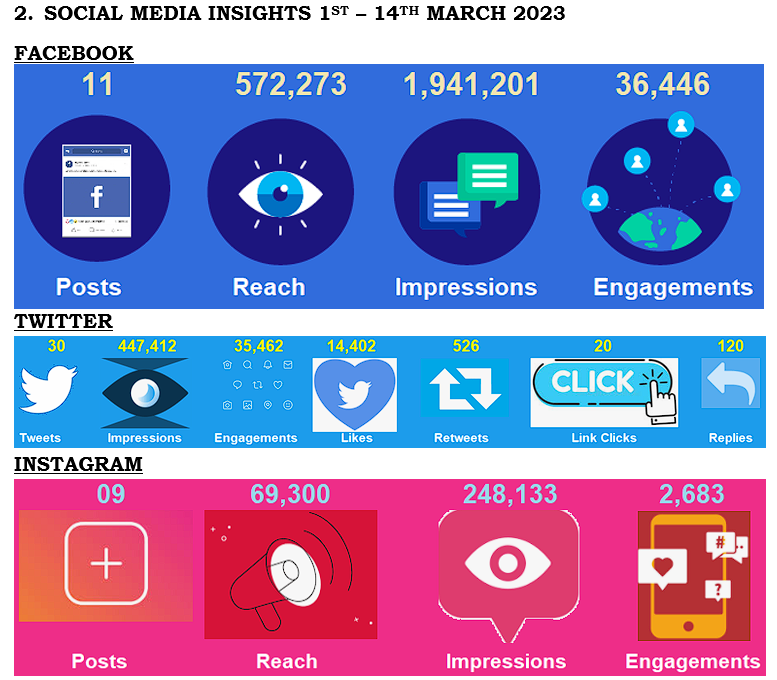


PREPARED BY

OVERVIEW
This report presents findings from the analysis of the coverage of children-related issues in Uganda for the period 1st – 14th June 2023 by various online media platforms. The main method used was content analysis.
Overall, the analyzed data results show that 540 articles were published online on children and children-related issues in Uganda, indicating an increase of 99 articles from those published during the last two weeks of May 2023.
One hundred ninety-five (195) articles focused on keeping children learning[1], 186 on keeping children safe[2], and 159 were on keeping children alive[3].
BI-WEEKLY ANALYSIS OF EDITORIAL AND JOURNALISTIC REPORTING TRENDS BY ONLINE PUBLICATIONS ON CHILDREN IN UGANDA (JUNE 1ST– 14TH 2023)
- INTRODUCTION
Ultimate Multimedia Consult (UMC) is required to present to UNICEF Uganda an analysis of editorial and journalistic reporting trends on children-related issues in online publications every two weeks. This report presents findings on how online publications covered children-related issues for the first two weeks of June 2023.
The report also shows how UNICEF Uganda messages, including press releases, reports, and expertise, are reported on by online publications. In addition, the report gives insights into the accuracy and appropriateness of the information provided on children’s issues.
The analyzed content was drawn from news websites based in Uganda like: NTV Uganda, Bukedde and Capital FM; other websites like: Daily Monitor, New Vision, Uganda Radio Network, Chimp Reports, Daily Express, Mazima News, PML Daily, Nile Post, The Independent, and Various YouTube Channels like UBC TV, Spark TV, Bukedde TV, NTV Uganda, NBS TV, Urban TV among others, as well as websites based in other countries. The analysed data was accessed from online publications/platforms.
- ONLINE ANALYSIS
We captured 540 articles from online publications reporting children-related issues during the first two weeks of June 2023 (1st – 14th) indicating an increase of 99 articles from those recorded during the last two weeks of May 2023. Below is a table showing a breakdown by publication, and category.
- CATEGORIES
One hundred ninety-five (195) articles were centered on keeping children learning.
Issues on keeping children safe were reported in 186 articles.
Articles on keeping children Alive were in 159 articles.
Graph showing the distribution of story articles in terms of categories

- GENDER OF AUTHORS
During the period under review, male authors reported and or wrote most articles. While some articles had more than one author, 62 articles had no authors specified.

SENTIMENT
We found that 39% of the articles on children issues published online during the first two weeks of June 2023 had a positive sentiment[4]. Children-related articles with neutral sentiment were the least in number.

Out of the 146 children-related articles we recorded having a negative sentiment, two (02) articlesmentioned UNICEF. The mention was in the articles below;
- https://www.devdiscourse.com/article/headlines/2486267-one-in-every-10-children-works—instead-of-going-to-school One in every 10 children works – instead of going to school
- https://www.monitor.co.ug/uganda/oped/letters/child-labour-the-unhidden-evil-4269252 Child labour, the unhidden evil
- SHARE OF VOICE
Majority of the articles recorded during the first two weeks of June 2023 had a high share of voice[5] on children and children-related issues.

- TYPE OF COVERAGE
The graph below shows the type of coverage of children-related articles online during the period 1st – 14th June 2023

- MESSAGE FIDELITY
The majority (91%) of the children-related articles recorded during the first two weeks of June 2023 had high message fidelity. This implies that they laid out their messages clearly through the use of facts, statistics, audio-visuals and sources, making it easy for users to understand them as intended by the authors. Such articles are credible and trusted by content consumers.

- NATURE OF QUOTES
Out of the 540 children-related articles we recorded from online publications, 513 had direct quotes, indicating journalists’ sourcing and clarity in presenting news. One (01) article had no quotes at all.

- USE OF VISUALS
In the articles recorded during this period, 532 hadaudio–visuals (photos, videos, audio, and graphics). 08 had no visuals, as shown below.

It should be noted that articles with visuals are understood much better than those without.
- ISSUES COVERED
The graphic below shows the topics covered in children-related articles online. The size of the words in the figure below and the numbers shown in the brackets (after the graphic) reflect the frequency at which the various topics were reported on in online publications.

From the articles captured, we noted that Education (115 times) was the most covered issue during this period. This was followed by:
- Child-health (93)
- Child protection (46)
- Child-talent (45)
- HIV/AIDS (19)
- Sports (18)
- Climate Change, Defilement, parenting (11)
- Child Trafficking (22)
- Child death (18)
- Homosexuality (14)
- Vaccination (14)
- Refugees (13)
- Teenage pregnancy (6)
- Child-labour (15)
- WASH (8)
- Charity (7)
- Note that some articles covered more than one issue
- ARTICLES DISTRIBUTION PER REGION

Most (301) of the articles recorded were from the Central region, while the Northern region had the fewest articles at 49, as represented on the graph above.
While some articles cut across different districts, others were general in nature and therefore were not recorded as coming from any of the four regions of Uganda.
From the figure above, Kampala District in the Central Region had the highest coverage with 236 articles.

Kampala (236), Wakiso (24), Mukono (11), Mpigi (3), Masaka (8), Mityana (9), Namutumba (2), Kalangala (2), Gomba (1), Bukomansimbi (1), Kalungu (1), Lwengo (1), Luwero (1), Butaleja (1).

Jinja (8), Bukedea (1), Kamuli (3), Soroti (9), Bulisa (2), kween (1), Bukedi (3), Madi Okollo (1), Nebbi (1), Zombo (3), Bwikwe (1), Mbale (7), Busia (9), Buyende (2), Bugiri (5), Lugazi (2), Buko (2), Serere (1), Iganga (2), Ngora (1)

Kabarole (4), Hoima (7), Rukungiri (2), Rwampara (1), Bunyangabu (3), Bushenyi (3), Isingiro (1), Kagadi (3), Kikuube (3), Kibale (1), Kyotera (1), Kasese (10), Kamwenge (1), Rubanda (2), Ntungamo (3), Kisoro (2), Kabale (6),) Rwampara (1), Kakumiro (1), Masindi (2), kanungu (1), Rukiga (1)

Katakwi (2), Yumbe (3) Moroto (5), Lira (5), Amolator (1) Amuria (1), Kaberamaido (1), Kapelabyong (1), Kumi (2), Arua (12), Nakapiripiriti (1), Oyam (1), Omoro (1), Kapchorwa (1), Gulu (9), Adjumani (1), Moyo (1), Terego (1).
- UNICEF UGANDA WEBSITE ARTICLES
This part analyzes UNICEF Uganda messages, including press releases, reports and expertise, and how they are reported on by UNICEF Uganda website.
During the first two weeks of June 2023, one (01) article was published on the UNICEF Uganda website.
| Story link & title | Search Engine Optimization (SEO)[6] | Comments | |
| 1. | https://www.unicef.org/uganda/stories/braille-bricks-transform-learning-children-visual-impairment Braille bricks to transform learning for children with visual impairment | PhotosGood use of keywords | Outbound and inbound links on keywords and characters in your articles can make them stand out in Google searches. Keywords can also be included as tags.Headlines can also be made keyword-rich to make articles more searchable and attract readers’ attention.Use of videos in the articles is commendable as it provides extra information on the topic as well as rich media.Exploit other visuals like graphics and animations whenever possible. Multimedia articles are not only easy to understand but also stand out in online searches.Use of block quotes, bolding key phrases and putting some parts of the article in list form makes it scannable and easy to read |
- UNICEF UGANDA MENTIONS
During this period, UNICEF Uganda was mentioned 13 times in 540 children-related articles in online publications. Below are links to the articles where UNICEF Uganda was mentioned during the first two weeks of June 2023:
EDUCATION
- https://www.unicef.org/uganda/stories/braille-bricks-transform-learning-children-visual-impairment Braille bricks to transform learning for children with visual impairment
- https://nation.africa/kenya/news/gender/unicef-launches-period-tracker-app-for-adolescents-4258704 Unicef launches period tracker app for adolescents
- https://www.devdiscourse.com/article/headlines/2486267-one-in-every-10-children-works—instead-of-going-to-school One in every 10 children works – instead of going to school
- https://www.equaltimes.org/around-the-world-cities-are-seeing Around the world, cities are seeing the benefits of creating more space for children to play
IMMUNIZATION / VACCINATION
- https://www.miragenews.com/vaccine-confidence-plummets-in-africa-amid-1023651/ Vaccine Confidence Plummets in Africa Amid Pandemic
- https://www.afro.who.int/countries/uganda/news/routine-yellow-fever-vaccination-children-taking-shape-uganda Routine Yellow fever vaccination for children taking shape in Uganda
- https://www.gavi.org/vaccineswork/big-immunisation-bounce-back-happening Is the big immunisation bounce-back happening?
OTHER MENTIONS
- https://www.monitor.co.ug/uganda/magazines/healthy-living/importance-of-menstrual-hygiene-for-women-with-disabilities-4258506 Importance of menstrual hygiene for women with disabilities
- https://www.newvision.co.ug/category/politics/why-women-in-business-need-mentorship-161703 Why women in business need mentorship
- https://www.devdiscourse.com/article/law-order/2479420-central-africa-faces-turning-point-amid-multiple-crises Central Africa faces ‘turning point’ amid multiple crises
- https://www.monitor.co.ug/uganda/news/national/address-causes-of-child-labour-unicef-boss-tasks-govt-4267964 Address causes of child labour, UNICEF boss tasks govt
- https://www.monitor.co.ug/uganda/oped/letters/child-labour-the-unhidden-evil-4269252 Child labour, the unhidden evil
- https://www.miragenews.com/unaids-executive-director-honored-with-activism-1025814/ UNAIDS Executive Director Honored with Activism Award.
- COMPARATOR MENTIONS
The Ministry of Health (MOH) was the most mentioned comparator in 34 articles, followed by, Ministry of Education & Sports (MoES) and United Nation (UN)15, World Health Organisation (WHO ) with 13,among other comparators.
Below is a breakdown of all comparator mentions
| COMPARATOR | NUMBER OF MENTIONS |
| Ministry of Health (MOH) | 34 |
| Ministry of Education & Sports (MoES) | 15 |
| United Nation (UN) | 15 |
| UNHCR | 7 |
| WFP | 1 |
| Uganda Red Cross | 2 |
| World Health Organization (WHO) | 13 |
| NDA | 4 |
| CEHURD | 1 |
| USAID | 5 |
| UWESO | 1 |
| Plan International | 1 |
| UNFPA | 6 |
| MGLSD | 3 |
| UNFPA | 1 |
| PEPFAR | 7 |
| UNAIDS | 5 |
| UCRNN | 1 |
| World Bank | 2 |
| IMF | 1 |
| Oxfam | 1 |
| SEATINI Uganda | 1 |
| NARO | 1 |
| ILO | 4 |
| Action Aid | 1 |
| UWOPA | 1 |
| RAHU | 1 |
| Gavi | 1 |
| Joy For Children | 1 |
| IOM | 1 |
| MADIPHA | 1 |
| WFP | 1 |
| UNODC | 1 |
| UNESCO | 1 |
| KCCA | 1 |
| IAAD | 1 |
- SOCIAL MEDIA INSIGHTS 1ST – 14TH JUNE 2023



YOUTUBE


- SOCIAL MEDIA TRENDS
This part looks at how different media organizations in Uganda posted about children-related issues on social media. During this period, NTV Uganda, The New Vision, Nile Post, NBS TV and Daily Monitor posted the most on children. Posting was mainly on aspects of immunization, vaccination, education, girl child, schools, accidents, pediatrics, child malnutrition, homosexuality in schools, teaching, child murder, child health, teachers, menstrual health, school feeding, child marriage, teenage pregnancy and other sex-related offences against children, reproductive health, maternal and neonatal health, child protection, parenting and violence against children, among others. Below are snippets from and links to the posts captured from social media in the first two weeks of June:


https://www.instagram.com/p/Cs8a3u4sE-X/

https://www.instagram.com/p/Cs8Kvo6MXBP/










https://www.facebook.com/NTVUganda/photos/a.319879798060481/6412317322150001/

https://www.facebook.com/NTVUganda/photos/a.319879798060481/6412300435485023/








https://www.instagram.com/p/CtL3o-MNTlg/

https://www.instagram.com/p/CtLRTi0Ohr5/




















[1] Reports categorized as such may connote content published in a context of improving and addressing the issues concerning both the informal and formal education of a child, including early and progressive learning
[2]Articles in this category may refer to a journalistic report(s) written and presented in the context of the social safety and welfare including the security of a child. Such articles include any content that addresses issues that threaten the lives of children like physical assault, psychosocial injury and threat.
[3]. This is concerned with articles and journalistic content that address the health of children in Uganda. It may also entail articles that look at the welfare of pregnant mothers or maternal health in general.
[4] Sentiment (also known as tonality) is used to measure how messages contained in children related articles are portrayed in the media in relation to UNICEF’s mission to advocate for the protection of children’s rights, help meet their basic needs and expand their opportunities to reach their full potential. Sentiment is normally categorized as positive, neutral or negative.
[5] The measure of the publicity/exposure a brand or issue receives in a story compared to its competitors or other issues.
[6] Search Engine Optimization is the process of improving the content on your website to increase its visibility for relevant searches online.



